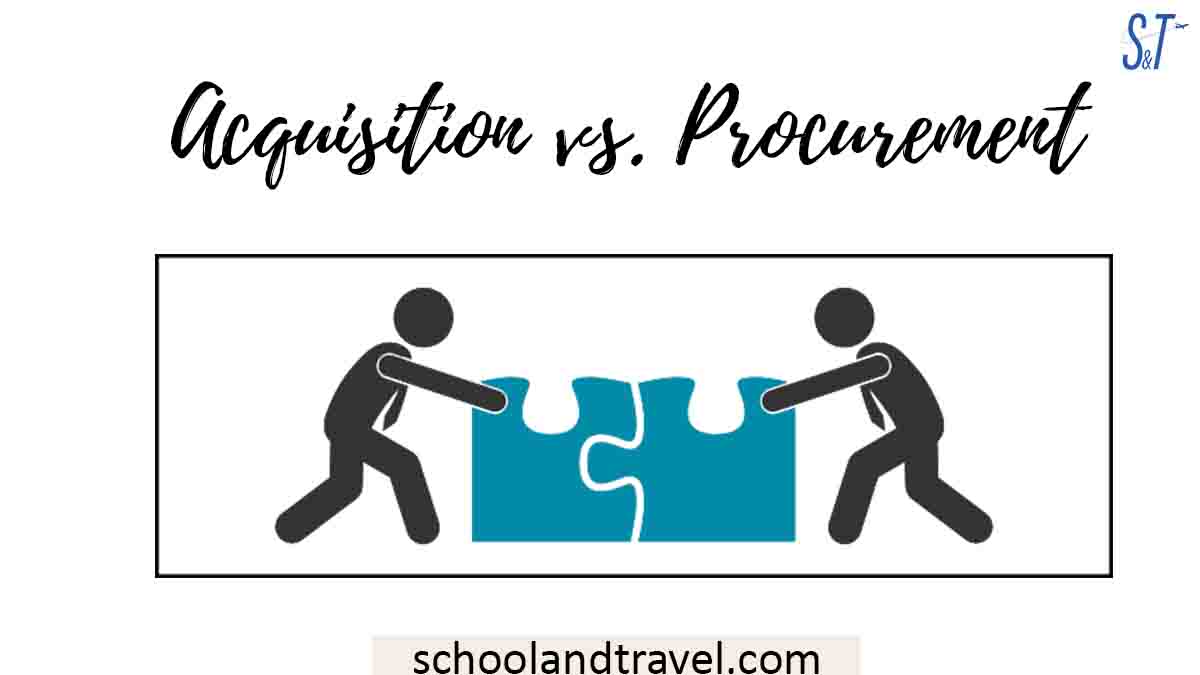“Acquisition vs. Procurement” is an interesting comparison amongst businesses and company owners. They have similar meanings, and in most contexts, people tend to use them interchangeably.
But in the actual sense, Acquisition and Procurement are two different things, though they are similar in few aspects.
This article will explain these words and help you understand the similarities and differences between them.
Acquisition vs. Procurement
What is acquisition?
Acquisition occurs when one business purchases another business to become the new owner.
In some cases, the acquired company will cease to exist, making the joined business expand and become more valuable to those who acquired it, their customers and employees.
There are some specific things to put into consideration before a business concludes to acquire another business.
The owner should inquire how the new development will favour him or her and what available resources the new product would give him or her access to.
How to grow a business through acquisition:
Growing one’s business through acquisition is a common practice in which the primary objective is diversification and market positioning.
But, before you acquire any business, you should ask yourself these three important questions:
- Will the business in question make your business more valuable?
- Is the business you want to acquire in-line with what you do, or is it already where/level you want your business to be?
- Is your main aim to reach more customers, own an intellectual property you don’t have, or both?
One of the surest ways to grow your business quickly is to acquire another business through acquisition. Acquisition mainly occurs between two companies whose net worth are not equal.
A financially bigger company develops the smaller one, while the smaller company continues its operations under the ownership of the larger company. However, in most cases, the name of the acquired company ceases to exist.
One of the significant acquisition objectives is to gain a better competitive advantage by merging resources with another firm. At the same time, the target company will be completely under the control of the purchasing firm.
Acquisition does the following:
- Raise market share.
- Expand the workforce.
- Yield revenues.
- Achieve economics of scale.
- Minimize costs through shared budgets and creates purchasing power.
- Broaden the existing service or product offering.
Acquisition vs. Procurement
Major types of Acquisition
Let’s briefly look at various types of Acquisition classified based on the company’s nature of business.
Horizontal Acquisition:
This occurs when a company acquires another company in the same business line, sector, or industry. A typical example of horizontal Acquisition is Facebook acquiring WhatsApp.
WhatsApp still exists with its initial brand name, but the ownership has changed to Facebook. Talking about the nature of business, both Facebook and WhatsApp are in the same business line, which is social media.
Through horizontal Acquisition, both have benefited from each other.
Vertical Acquisition:
It happens when a company buys one of these input suppliers, distributors, or the company that buys its products. A good example of this is when a cement company acquires a company that supplies raw materials like limestone, clay and marl.
Conglomerate Acquisition:
This occurs when the acquiring and the target company are in different types of business, sector, or industry. Diversification is the major objective of this kind of Acquisition.
For instance, when a technology company acquires a fashion company, conglomerate acquisition takes place.
Congeneric Acquisition:
It is the opposite of Conglomerate Acquisition. It occurs when companies with similar features come together, it can be either similar production, technology, distribution channel, etc.
Read this: Liase or Liaise – Which is Correct?
Advantages of Acquisition
- Customers, employees, and assets will increase automatically.
- The expected growth would be achieved by both owners and investors.
- Resist economic crisis easily by heightening the capacity to make a profit.
- Acquisition reduces the risk of customers’/market’s reaction to your growth, also reducing the amount of money you will spend in developing new environments, products and services.
- There will be instant and long-term tax merits.
- Access to geographical areas and important patronizers that have been investigated and approved to be ready to produce profits.
Disadvantages of Acquisition
- There will be an increment in the total acquisition cost from what was expected if the financial foredeal isn’t projected correctly.
- There will be distractions from daily business practices by attending to acquisition challenges that require immediate attention.
- In the end, shareholders and investors are the ones paying the price of a long wait to appreciate the advantages of an acquisition.
- You might end up acquiring the wrong company, which in the end will result in a failed acquisition.
- If the deal was not carried out efficiently by the two parties, you might end up losing crucial customers and employees.
- Investors risk financial damage if the company they acquired does not have sufficient value to justify the investment.
- Bewielding more people and operational complexity, coupled with maintaining a presence in multiple markets.
- Keeping a bigger and manifold customer base and also handling a complex products and services portfolio.
Acquisition vs. Procurement
What is Procurement?
Procurement is simply the practice of purchasing goods and services mostly for business purposes. The role a buyer plays in procurement is, identifying and procuring the goods and services required by an organization or company.
The procurement buyer identifies all the exterior materials needed in an organization and finds service providers who can provide:
- The goods.
- Taking control of price negotiation.
- Arrangements for buying and delivering the goods.
Read this: Colleague vs Coworker – What’s the difference?
What does Procurement do:
- Pinpointing the organization’s problems and concerns and take appropriate measures to ensure they are all sorted out.
- Procurement buyer identifies customers’ issues and complaints and resolves them accurately.
- Determine the buying needs of an organization.
- Negotiate prices directly with the suppliers to come up with the best rate and payment options.
- Procurement buyer, manage the inventory, approve orders, and negotiate contracts.
- Keeps accurate records of bought goods and stocks.
- Manege suppliers performance and build a good relationship with them.
- Forecast upcoming demand.
Procurement buyer should have the following skills:
- Good experience in prioritizing and organizing work activities.
- Ability to multitask to meet up with timelines and deadlines.
- Good knowledge of cost control functions to perform cost control processes and make appropriate business decisions.
- Familiarity with the designing process, project management, inventory and arithmetic skills to perform accurate calculations.
- Skills in Ms word, Excel spreadsheets, Outlook, database, and word processing software.
- Good verbal and written communication skills.
- Good in negotiation, customer services, and also have good consulting skills.
Benefits of Procurement
The following are the main benefits of procurement.
- It reduces total cost across the value chain.
- It aids higher efficiency.
- To gain a competitive advantage, procurement professionals are expected to be innovative.
- It reduces risk.
- It supports supply chain resiliency.
- Helps in obtaining the best price for goods and services.
- Ensuring quality control.
- Negotiating better contracts.
- It increases business profitability.
Acquisition vs. Procurement
Types of Procurement
Let’s quickly conclude with types of procurement. Below are the significant types of procurement.
Indirect Procurement:
This deals with buying goods that are important for daily tasks but has no direct contribution to the company’s bottom line.
Direct Procurement:
Once you obtained anything that’s required to produce an end product, direct procurement has occurred. Take manufacturing company for instance, this can be raw materials and components.
Goods Procurement:
This is the buying of physical goods. Sometimes it can include software subscriptions.
Services Procurement:
This type of procurement is in charge of procuring human-based services, which solely depends on the company.
Conclusion:
Acquisition is the process through which one business acquires another in order to become the new owner. At the same time, procurement is the act of acquiring products and services, primarily for commercial objectives.
Awesome one; I hope this article answered your question.
Share this Information.
Related articles:
- How to Create a Balanced Plate: The Key to Healthy Eating
- How to Start a Virtual Book Club with Friends
- The Top Credit Score Hacks Every Young Adult Should Know
- The Pros and Cons of Rental Property as a Passive Income Stream
- Enhancing Your Clinical Psychologist Job Prospects with Professional Help
- The Impact of Graphic Design School on Your Future Earnings Potential
- 7+ College Scholarships for Muslim Students (FAQs)
- Flavor of the Month Scholarship 2024 (Requirements, FAQs)
- Vegetarian Scholarship (Requirement, Deadline, FAQs) | 2025
- John and Abigail Adams Scholarship 2022-2024 (Eligibility, Deadline)






